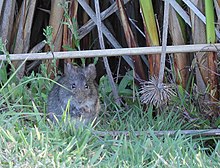Southern African vlei rat
| Southern African vlei rat | |
|---|---|
 |
|
| A southern African vlei rat, grazing beside a reed-fringed dam | |
| Scientific classification | |
| Kingdom: | Animalia |
| Phylum: | Chordata |
| Class: | Mammalia |
| Order: | Rodentia |
| Family: | Muridae |
| Genus: | Otomys |
| Species: | O. irroratus |
| Binomial name | |
|
Otomys irroratus (Brants, 1827) |
|
The Southern African Vlei Rat (Otomys irroratus) is a species of rodent in the Otomys genus ("vlei rats") of the family Muridae in the order Rodentia. This is the type species of the genus. It is native to the grasslands and swamps of southern Africa where it is a common species.
The Southern African Vlei Rat is a large-sized rat with dense and continuously replaced shaggy fur. The head is large, the ears small, and the tail short. The dorsal parts are generally gray, brown, or black. The ventral parts are some shade of paler or darker grey. All of its digits are clawed, and the hind claws are longer than the fore claws. The head-and-body length is about 160 mm (6.3 in) and the tail about 100 mm (4 in). Both males and females have a similar mean mass of 143.7g.
The range extends from the far South Western Cape of South Africa, around the southern and eastern coast and adjacent interior, to subtropical regions in southern Natal. This part of its range includes Lesotho. Further north, it no longer occurs around the actual coast. Inland however, its range extends north to tropical areas, nearly to the northern boundary of the Transvaal, including parts of Swaziland. An apparently isolated population occurs still further north in tropical eastern Zimbabwe and adjacent Mozambique. Its habitats include temperate low-altitude swamps and grassland, and subtropical and tropical high-altitude grassland, swamps, and plantations. It is a terrestrial species that lives above ground in an open, bowl-shaped nest made of shredded grass near marshy areas with a lot of vegetation.
The Southern African Vlei Rat is mainly active at dusk and dawn. Most are diurnal, although some Vlei Rats show nocturnal activity. It shares and creates runways with other coexisting species through the vegetation as it forages on the green vegetation on which it feeds.
...
Wikipedia

